
13-17 February 2017. There are over two million people in Havana, over two million stories, all with similarities, and yet each unique. This is the story of our friend “Pedro”:
Pedro is a research scientist. His wife is also a professional, in a medical field. They have one child, a six-year-old boy. Unfortunately due to illness his wife is unable to work. With two professional salaries Pedro and his wife probably earned about $14,000 per year. When you factor in free health care, free education at all levels, subsidized childcare, and the relatively low cost of essential goods in Cuba, their income probably allowed them to have a reasonably good life, albeit without the everyday abundance of goods we take for granted in the west. With only one salary it’s impossible. Pedro’s credentials are such that he can get research fellowships at prestigious North American universities. This means that he is away from home for four to six months of the year, but it also means he can earn an adequate income to support his family. It is pretty much the only way he can earn an adequate income to support his family short of taking a second job completely outside of his field. Like the electrician driving a bicycle (bici pronounced “beecee”) taxi.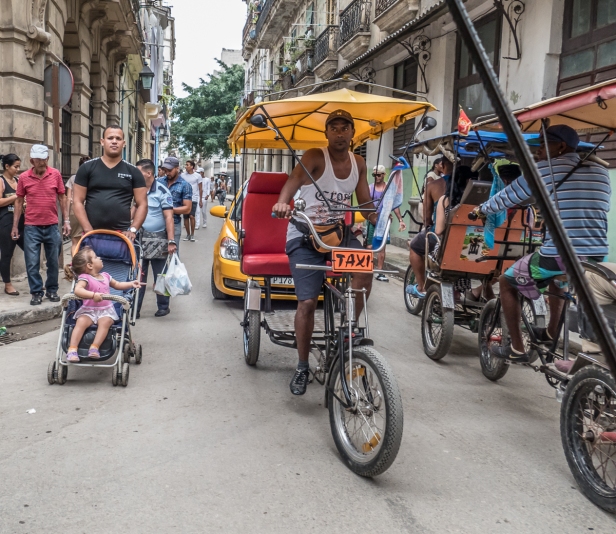
We hail the electrician in his bici taxi one evening. He speaks good English and is motivated to learn. He’s an electrician but his government wage is not enough to support his family so he transports tourists in his taxi at night giving him access to hard currency. I don’t know for sure but it’s highly likely his wife also works. He has two children, aged ten and twelve. He tells us that his dream is to be a fisherman in Alaska for five years to make enough money to set himself up in Havana with a casa particular. All owners of casas particulares, which are essentially tourist guesthouses, or B&Bs, make a good income from foreign tourists. I don’t know where the dream of Alaska has come from. He is young and strong, but has never been a fisherman, and certainly never experienced the deep freeze that is Alaska. Perhaps he saw a TV documentary that sparked his imagination.
Of the forty-two members of Pedro’s graduating class he is the only one still living in Cuba. All the others have left seeking a better life elsewhere. This is one aspect of Cuba’s brain drain. The other is that highly skilled professionals are seeking work in the tourism industry where good salaries and tips add up to a decent income. English teachers leave teaching to become tour guides, while doctors and engineers also leave to become waiters and the like. Anyone even remotely connected with tourism, be it bellhop, or bici taxi driver, gets access to the hard tourist currency, worth twenty-five times more than the local Cuban currency.
The electrician’s story reminded me of a young woman we met in Sapa, Vietnam back in 2010. She was of the Black Hmong tribe, twenty years old back then, married and six months pregnant. She had taught herself English by talking to, listening to, and learning from the tourists. She was our guide for the day hiking through the villages and rice fields of northern Vietnam. She said that life there was too hard and her dream was to move to Thailand for the chance of a better life.
I think it is a common theme amongst poor people throughout the world, this dreaming of a better life, somewhere, somehow, but it seems more wasteful to me in Cuba’s case. The system is set up to support everyone through a high level of education and then fails them, although Pedro did tell us that Raúl Castro is focused on developing the economy so perhaps things will gradually improve. Meanwhile most ordinary Cubans struggle with barely enough to live on aided by a truly remarkable collection of work-arounds and innovations to get what they need.
Like many crowded inner cities living spaces in Old Havana are small and crowded so a lot of life happens on the street.


and because it’s hot inside, and also probably because they want to know what’s going on, people hang out on the sidewalk, or on the balcony.


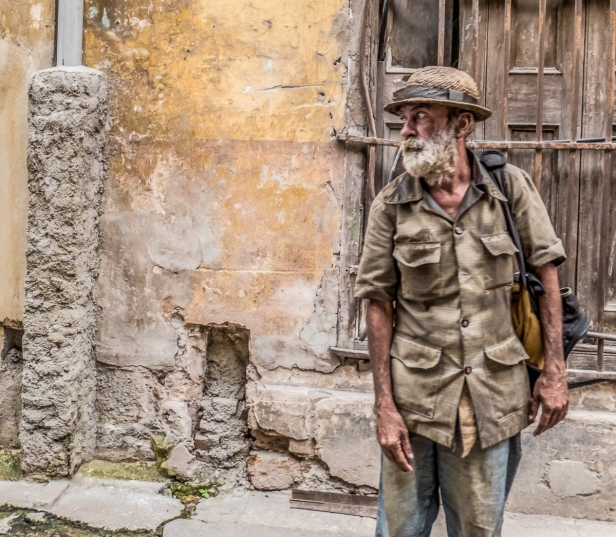
We see a woman wringing her laundry onto the street from her balcony,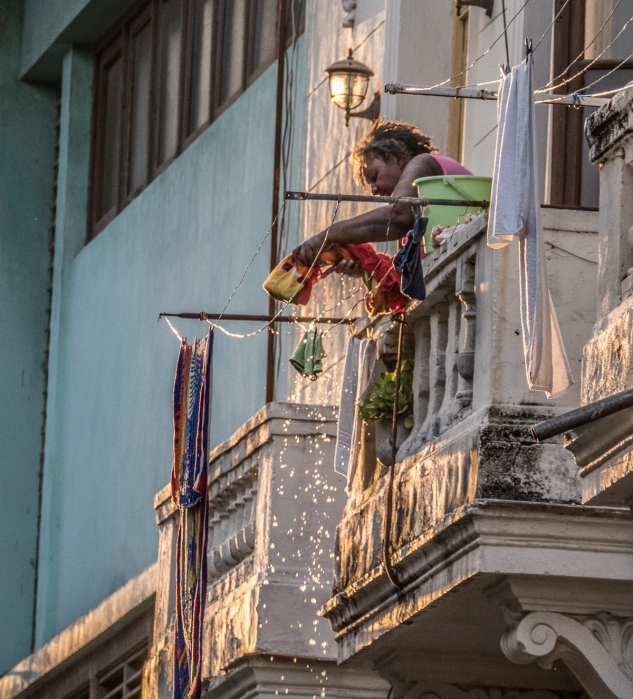
a whole pig being roasted on the sidewalk, and a man walking by with a live goose under his arm. A hutia is a small brown mammal, native to Cuba, and about the size of a large domestic cat. We see one in a cage sitting on the sidewalk. It may be a pet. It is more likely dinner. People do what they need to do. What we experience on the street is usually lively with a sense of fun, often with music in the background, but sometimes conversations get animated and sound more like arguments. It’s life in the raw, exposed for all to see.
There is a perennial shortage of food in Cuba, and the lack of regulation of vendors creates high prices for ordinary people. Farmers bring their produce to the wholesale market in Havana where it is sold in bulk. Vendors then resell it in stores and small outlets throughout the city at three times the price. You would think that in a country where the government regulates just about everything that they would regulate the sale of something as essential as food. I am perplexed by Cuba.


Much that we take for granted is not available, though all the small stores we go into in Old Havana have plenty of liquor for sale, and once again I am perplexed by Cuba.
Most food is imported so naturally restaurants don’t always have what you’d expect. We eat in a variety of restaurants and the food is always just okay. We go with Pedro one day to his favourite Old Havana restaurant. It’s half the price of the places we’ve been eating at. Don and I share prawns and rice. It’s good enough though not outstanding. Some of our best meals are those we have at the casas particulares where we stay. One memorable meal is dinner for 7 CUC (US$7) at the casa in Havana: a really good soup with lots of vegetables, a salad, and beautifully cooked chicken with fried banana and beans-and-rice. And breakfasts there are plentiful and excellent.
From Don: For our last dinner in Havana before going to Viñales Alison wanted to eat at one of the restaurants in the Plaza Viejo where we’d always heard good live music every time we went by. As expected the drinks were cold, the music was hot, and the food was lukewarm. We got fabulous live music for the first fifteen minutes we were there then the band took a break, and they were still on a break by the time we were ready to leave. I guess we just didn’t have enough staying power.

As well as the music nothing seems to be more quintessentially Cuban than the classic cars. There are an estimated 60,000 pre-1959 American cars still cruising the streets of Cuba, maintained for fifty years or more with hand-made jerry-rigged parts, sheer determination, and regular Hail Marys. The embargo on car parts has produced some of the most creative mechanics in the world. The classic cars are everywhere. They range from those that appear to be in perfect condition for joy-riding tourists to those held together with string and paperclips and used as transport for ordinary people wealthy enough to own a car at all.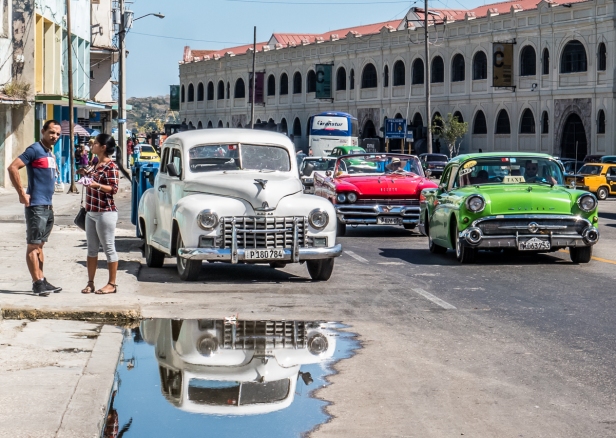
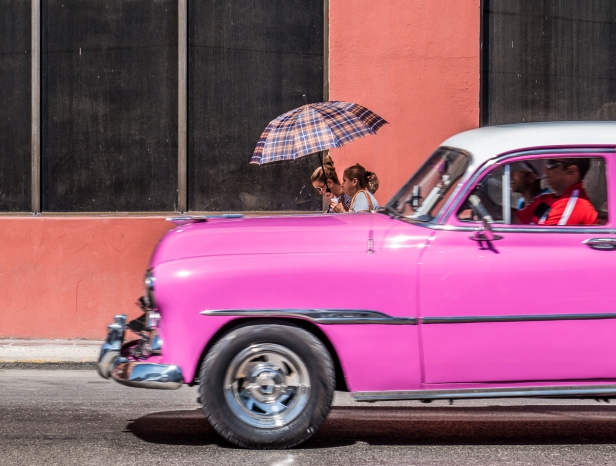
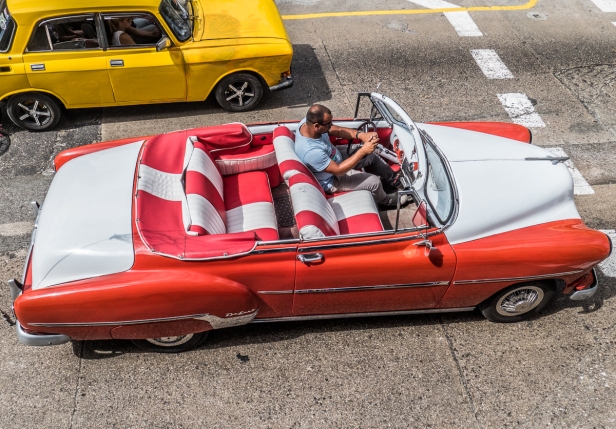
The streets are also busy with motorbikes with hand-built side-cars,
this rare and unique Harley,
horse-drawn vehicles, this one ironically caught passing the Peugeot sales room,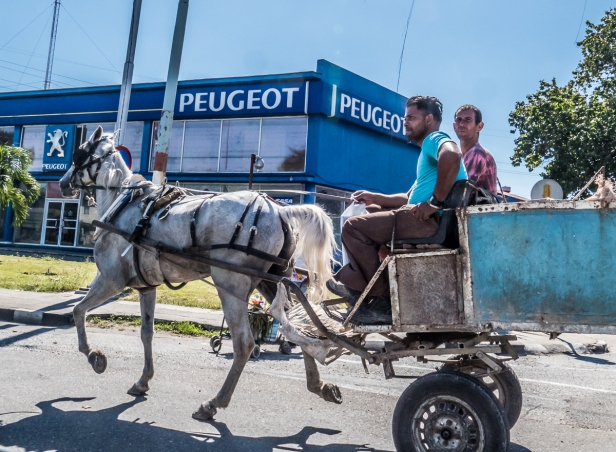
and people-powered custom-built tricycles.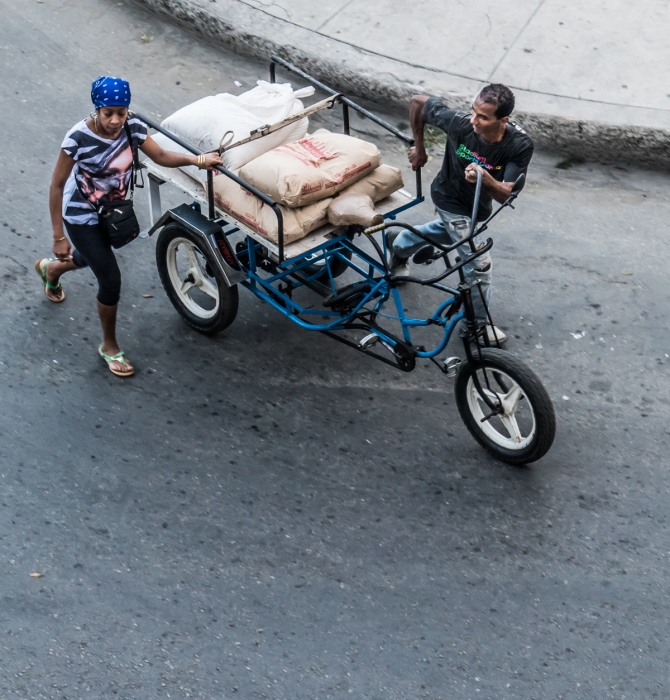
As with all aspects of Cuban life the system challenges people to be creative, resourceful, and ingenious.
Pedro’s favourite line for expressing the bewilderment that is Cuba is and everything changed overnight! They were not allowed cell phones. Then suddenly everything changed overnight and one morning cell phones were allowed. They were not allowed access to the Internet. Then suddenly everything changed overnight and one morning purchase of Internet cards was allowed. For a long time they were only allowed to import car parts. Then everything changed overnight and now they can import cars. And so it goes.
There is no universal Internet in Cuba. It is available at the high-end tourist hotels, and with a bit of trial and error we find the best in Old Havana – the Hotel Iberostar Parque Central where you can buy a five-hour card that actually gives you six hours and forty minutes for $10. We sit with our laptops in the hotel’s cool comfortable leafy café eating club sandwiches and drinking coffee or a beer and catching up on emails, and can easily pretend we are anywhere but Cuba. Meanwhile outside ordinary Cubans make use of the hotel’s Wi-Fi signal to access the Internet.
They are not allowed to go into the cool welcoming interior of the Iberostar and up the stairs to purchase an Internet card from the nice man in the business centre. Instead they line up outside one of several ETECSA offices throughout the city, possibly for as long as an hour to buy their one-hour cards. We know this because we too stand in one of these lines, more than once, until we discover the Iberostar.
We notice a man waiting outside the ETECSA office. He never goes in. Every now and then he exchanges some money for a card with someone who has just emerged from the office. We watch this for quite a while. He buys several cards but never goes inside the office. Pedro tells us that he is probably buying them to resell to people who don’t want to wait in line. He can’t go in himself since you can only buy a maximum of three one-hour cards at a time, so he has others buy cards for him, one here, another there, until he has a stack he can resell. It’s typically Cuban. Everyone is looking for any way to make a little extra money.
You never know, it’s probably coming, suddenly everything will change overnight and there will be Internet available for everyone.
As an independent traveller (as opposed to staying in one of the resorts) you will stand in line in Cuba. As a local even more so: for bus tickets, for Wi-Fi cards, even for eggs:
But it’s not all doom and gloom. Little girls with bright scrunchies play with stickers,

some guys in the back of a truck on their way to work shout and wave with joy as we drive by,
kids play on the way home from school,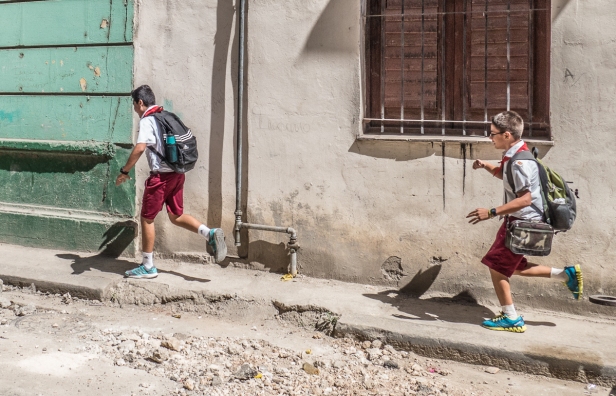
and individuality is seen everywhere.
Pedro tells us of some of the ingenious things Cubans have created to get around the restrictions they face. One is a special app for buying and selling second-hand goods, similar to Craig’s List. Internet time is expensive and hard to come by, but with the app you to only need to go online once a week to update it. You can then peruse it without the need for the Internet.
Another innovation is Cuba’s “cable” TV system. There is no cable TV in Cuba, but there are people who somehow have access to TV shows, and the ability to download them. The shows are then delivered weekly (for a fee) throughout the neighbourhood. People can pre-order the shows they want.
There is a kind of very subtle desperation here. People are poor and used to having to be extremely creative to make life work. As in most poor countries tourists are welcomed with genuine friendliness, but are also seen as a source of income. Havana is an extraordinary city, in part because of its rich history, and in large part because of the resourceful and creative Cuban people. Is everything wonderful? Not by a long shot, but the people are smart and resilient, and mostly the same as people everywhere – they do the best they can with what they’ve got, and no doubt music is one of the key ingredients that helps them cope.
We didn’t fall in love with Havana. We were enchanted with the beauty of the buildings, both those restored to their original splendour and those weathered by time and neglect but still proudly displaying the loveliness and integrity of design from earlier times. We were fascinated with the life on the streets, the raw energy, the camaraderie, the music. And it’s impossible to miss, no matter the hardships, the ordinariness of it. People are people, just going about their lives and making the best they can of it in circumstances over which they have little control. They laugh, they cry, they play, they work, they get exhausted, they have fun, they fight, they love. It is a grand and unique city, and for all Cuba’s troubles, Havana is one of those great cities of the world that calls out to be seen.
Next post: The joys of having a home, to be followed by several more posts about Cuba.
All words and images by Alison Louise Armstrong unless otherwise noted
© Alison Louise Armstrong and Adventures in Wonderland – a pilgrimage of the heart, 2010-2017.

I think my first Cuba post was entitled “Confounded by Cuba,” which is just another way of saying “I am perplexed by Cuba”! And that is the main takeaway for many people like you and I, people who are really trying to understand the way a place works, people who have seen lots of places in the world and how they work. It feels almost impossible to get a grasp on this place, a country at once beguiling and exasperating. The ingenuity and resilience of the people is one thing that is not confusing, but I so wish their lives could be a little easier.
As always, both your words and photos beautifully capture the essence of a people and place. Sometimes when I look at other people’s Havana photos, I am convinced that we snapped the exact same street or car or little old lady in a doorway, but then I realize that’s because the whole city looks like this!
LikeLiked by 1 person
Thanks so much Lexie. I just went back and had another look at your posts – and your *wonderful* photos that so perfectly captured Cuba. I looked at them and sometimes thought “why didn’t I think of that shot?” Still, I’m pleased with several of the images I did get. I remember when I read your post “Confounded by Cuba” that I didn’t really get it. I guess you have to go there to experience it first hand. It sure didn’t take me long to be confounded, perplexed, bewildered. You sum it up when you say “both beguiling and exasperating”. My sister was mainly exasperated. Perhaps it was harder for her as a solo female traveller but Cuba is the only country she has been to (and she has been to many) where she changed her flight to leave earlier. I too wish life could be a little easier for them. It seems to me there could be many simple fixes, but much of it seems so deeply entrenched. I’m both excited by and wary of the rising free market economy.
Alison
LikeLiked by 1 person
We agree again (of course!) – your last sentence perfectly sums up my feelings on the future in Cuba. I guess we all see others’ photos as being more masterful or better choices than our own; I can’t imagine anyone taking better photos ANYWHERE than you do! (I am not lying when I say that sometimes your pictures give me goosebumps – they are sooo good.) But thank you for the incredibly nice compliment.
LikeLiked by 1 person
Wow! THANK YOU!
A.
LikeLiked by 1 person
Excellent post! I’ve long wanted to see Cuba for a strange reason–the cars! I’m not a car freak, I’m just a bookish librarian, but wow! Those old cars! Puts planned obsolescence in its place (though for all the wrong reasons). I haven’t made it there yet–only as close as Puerto Rice, but I will someday. I just hope it is before they get all new Toyotas and Fords! (Though, of course, I’d be delighted if they could finally buy them.) Here’s the one book I have read about Cuba–very short read, but excellent. Happy Travels! https://hopewellslibraryoflife.wordpress.com/2016/01/16/reading-around-the-world-cuba/
LikeLiked by 1 person
Thank you so much for the book link! I have found her blog (translated into English) and look forward to reading it. The cars are amazing, and everywhere! I think change is coming to Cuba, but not likely overnight. There are signs of the beginnings of a free market economy (particularly for those people associated in any way with tourism) but it’s not going to happen overnight. I hope you get there! It’s so worth it.
Alison
LikeLiked by 1 person
Enjoy your stay.
LikeLiked by 1 person
Oh we’re not there now. We were there last February and I’m just getting caught up with blog posts.
LikeLike
We found Cuba perplexing too. We did homestays, and all of our hosts had second jobs (plus the homestays) to earn enough to live on. And we spent a lot of time standing in queues at ETECSA offices to buy internet cards.
Love your photos. The lighting is perfect.
LikeLiked by 1 person
Thanks so much re the photos Peggy. After two times standing in the Etecsa lines I was so glad when we discovered the Iberostar. I think just about everyone has second jobs. It’s the only way to be able to survive.
Alison
LikeLike
oh so wonderful…i also have fond memories of Havana…the streets and people…i will return…there is something special about the air and light…i love your photographs Alison…the tones and colours feel so right…big smiles from sunny etown! hedy 😀
LikeLiked by 1 person
Thanks Hedy. Especially thanks re the photos – I think I look a them for too long, sorting through to choose for the blog, then editing, that I stop seeing them, and can no longer tell if they are any good or not, so it’s nice to get some feedback. Havana’s an amazing place, but somehow impossible to get a handle on it. I doubt we will return, but I’m really really glad we went there. Smiles to you from very smokey Vancouver!
Alison
LikeLiked by 1 person
Well I appreciate them and your post work is beautiful you have your Alison signature that I see in your work…and yes I’ve learned more about my Cuban friends over the years….and what I can and can not do….sending healing rains from etown enjoy the long weekend! Hugs hedy 😀
LikeLiked by 1 person
An interesting and thoughtful commentary on life in Havana. Interesting to note it has not changed that much from the time we were there in 2013. At the time we travelled there, we were living in Nicaragua, the second poorest country in the Western hemisphere, (after Haiti.) So as a result, Cuba was not as perplexing to us, it just made sense, given the dire hardships people have dealt woth for decades. People in both countries are resourceful and resilient, Especially notable compared with all the waste which is part of the culture, in places like the U.S.
We had our best food by asking locals where THEY ate and on many occassions they took us to wonderful kitchens, homes of families where we ate some deliciously good home cooked meals. We came to the conclusion that most of the food in the casa homestays, were “dumbed down” ( devoid of spices etc) to what they think foreigners like. The assumption is that their food is too spicy for foreigners.
My favorite of your lovely, as always photos, is the one of the children playing, the street scenes.
Peta
LikeLike
Thanks so much Peta. You must have had a whole different experience going to Cuba from Nicaragua. But it still puzzles me. We’ve spent time in several very poor countries, and were certainly aware of the difficulties people face, and their amazing ingenuity, but somehow Cuba baffled us, and in the end we really couldn’t figure out why. Perhaps it’s the history – that in relatively recent times it was gorgeous and affluent and free and this somehow affects the energy of it all today. Anyway we couldn’t get a handle on it. Our best meals were at the casas, and I must admit I’m okay with dumbed down because I don’t like spicy food. I admit we could have been more adventurous in choosing places to eat!
Alison
LikeLike
Another great blog! Not just because I really want to go to Cuba, but the way you tell the story is great & your pics are fantastic, thanks!😃
LikeLiked by 1 person
Thank you so much for you wonderful compliments. I hope you get to Cuba one day; it’s quite amazing.
Alison
LikeLiked by 1 person
I plan for next july & I usually hit my targets, your posts are great, thanks
LikeLiked by 1 person
I have never visited Cuba, but is on my wish list. How long did you spend in Havana? Did you visit other parts of Cuba? Your account of Havana is fascinating, you certainly have learned a lot in what I assume was a short period of time? I love how you manage so well to get under the skin of a place and write about it in such a captivating way. Beautiful photos fit for an exhibition of “street life in Cuba” 😄
LikeLiked by 1 person
Thanks so much Gilda. I guess I’m just nosy 🙂
I do like to find out about the reality of places we visit, not just the tourist venues, though they are usually worth seeing also. We had a total of 6 days in Havana – 4.5 at the beginning and 1.5 at the end. We were able to learn quite a bit because of our friend Pedro. It always helps if you know someone in the place you’re visiting. After Havana we went to Viñales, Trinidad, Cay Iguana, and a national park near Trinidad, so there are many more posts to come about Cuba. I hope you get there!
Alison
LikeLike
Reminds me of Asia. The creativity and inventiveness. The hardship. The beauty. Great post – again.
LikeLiked by 1 person
Thanks Tracey. Yes, the creativity and inventiveness, and the hardship, reminded me of Asia too. I think as I answer comments I’m starting to get this idea that what makes Havana so different, and bewildering, is that the inventiveness and hardship takes place in such a setting – this magnificent city that was a flourishing bright jewel, like Paris, until very recently. No Asian city is like that, nor any other place that I can think of – where the beautiful past is there crumbling for all to see.
Alison
LikeLike
So beautifully told story, both in words and pictures! I loved especially the small girls, they are so beautiful, and the energy of the guys on the truck. This is what I have read about Cuba before: that people are happy in spite of all that poverty.
This sad story reminds me of Soviet Union where I was born. I wish my people were happier like Cubans. Maybe, we lack sun (and salsa :)). Hope to go to Cuba soon and experience it myself. Thank you for the post!
LikeLiked by 1 person
Thank you so much Marina. I was completely captivated by those small girls. I watched them for a long time. they were so sweet. And the guys on the truck were a lot of fun! It seems that people in Cuba are generally happy – we saw a lot of it despite the hardships. I think you are right – it’s easier to be happy with sunshine and salsa!
Alison
LikeLiked by 1 person
Thank you for sharing! I love the pictures of people (though sometimes I feel too shy to take them), and your shots capture the character and the energy that resonate in my own emotions. Thanks God for sun, salsa and that playful attitude that Cubans have! They set a great example of how to be happy, we in the Western world have a lot to learn from them. So long, let’s all dance salsa, maybe, it will help, hehe.
LikeLiked by 1 person
Love the pictures!
LikeLiked by 1 person
Thank you so much.
Alison
LikeLike
This is a great post Alison. Very informative. I would like to go to Cuba one day. I am a bit disappointed to read the food is disappointing in the restaurants at least. I love your photos, they are wonderful as always. Favourites – the fruit guy with the window behind and the lovely fruit shot underneath. Love the girls and their stickers. Photos with kids – love them. There is always a gap between me liking your posts and reading and commenting because I like to have time to read through them thoroughly. Louise
LikeLiked by 1 person
Thanks Louise. I have read that restaurant food generally is improving in Havana, but still our best meals were in the casas particulares. I remember an awesome lobster meal in Trinidad (with enough lobster left for sandwiches for the next day’s lunch)! The fruit guy and the one below are a couple of my favourites too. It’s a butcher’s shop behind the fruit guy. I wish I’d been able to get a better look at it. I watched the two little girls with stickers for a long time – I was first attracted by their fabulous hairstyles and scrunchies, but then just got into watching them playing.
And thank you for taking the time to read. I frequently do the same thing – waiting ’til I have time to read a post properly.
Alison
LikeLiked by 1 person
Wonderful stories of Cuban life.I guess, hardships have made them innovative, bringing out the best in life. Wish other peoples reeling under repressive regimes would take a leaf out of Cuban life and make the best out of what is on offer for them, instead of destroying themselves in rebelliousness.
LikeLiked by 1 person
Thank you so much Neofito. We have seen amazing innovation and ingenuity throughout the world in poor countries. It is a testament to the creativity of the human spirit and I love seeing the results of it. At the same time I do think there’s also a time for rebellion. Sometimes destruction of the old is needed for the new to emerge, though I’m not sure it’s been for the best in Cuba’s case even if they have found a way to make the most of the hardships they face.
Alison
LikeLiked by 1 person
A wonderful comprehensive report on Cuba, Havana in particular. Having been to so many parts of the world, you are able to see a place with a clear eye and an open mind. I love the pictures, especially of the vintage cars.
LikeLiked by 1 person
Thank you so much Darlene. The cars are amazing! And everywhere! We did a long distance trip in one which I’ll cover in the future. I’m glad you enjoyed the post.
Alison
LikeLike
Reblogged this on World4Justice : NOW! Lobby Forum..
LikeLiked by 1 person
Thank you!
Alison
LikeLike
Wonderful post and lovely photos! Thank you Alison 🙂
LikeLiked by 1 person
Thank you so much. I’m glad you enjoyed it.
Alison
LikeLiked by 1 person
What a great title for your post, Alison and, as always your eye and camera catch the smallest details to weave a unique story. I love the quote from your friend,Pedro, “And everything changed overnight!” which seems to sum up the magic of Cuba and the endless hope for a better/easier life. I’m saddened by such an astounding waste of intelligence and education while, at the same time, I find the sheer optimism and creativity of Cuba’s people to be nothing short of amazing. That, and never-ending patience, seem to be their greatest attributes! Anita
LikeLiked by 1 person
Thanks so much Anita. “Everything changed overnight!” was about the hope for a better life, but I think it was also his way of saying how ridiculous the whole system was, how fickle and random. One day you can’t have something, the next day you can, with no warning, rhyme or reason. And so they live, as you say, with optimism and patience. The creativity and ingenuity of people who have little blows me away every time! I think things will change gradually now, though I’m currently reading an insider’s blog (translated into English) which reveals how desperately inefficient and entrenched the system is.
Alison
LikeLike
Enjoyed reading this post (and Don’s contribution to it) and also (woo-hoo!) looking forward to “the nest” in the next post.
LikeLiked by 1 person
Thanks Pam, I’m glad you enjoyed it. I remember you’ve been looking forward to the new home post. I just wanted to get started on Cuba first. Anyway it’s up next!
Alison
LikeLike
When we lived in Mexico we were scheduled to take a tour to Havana but sadly the tour was canceled due to lack of participation. I’m not sure if we will ever reschedule a trip, given the long list of other places in the world we wish to explore. Thanks for sharing your perspectives. I am looking forward to your thoughts on your new home.
LikeLiked by 1 person
Cuba was fascinating and challenging, beguiling and frustrating. I’m really glad we went, but I can see why you’d think twice about it given there are so many other places to go. We were so close, being in Yucatan and Guatemala so it seemed like a natural time to go for us. We too have a long list of places we want to go!
Alison
LikeLiked by 1 person
beautiful picture
LikeLiked by 1 person
Thanks so much.
Alison
LikeLike
All the photos are amazing! Just by watching them you get the real piece of Cuba and move yourself to that place. Incredible.
LikeLiked by 1 person
Thanks so much Caroline. Cuba’s a fascinating place. I’m glad I was able to transport you there a little bit. It’s a great compliment!
Alison
LikeLiked by 1 person
What a great tribute to Havana. I am just amazed at the photos you get when you travel. It’s tough to look at your surroundings and take the shot at the right time, to enjoy the moment and to think about making memories. I am realizing that I may never get to Cuba, and thank you for ‘taking’ me there!
LikeLiked by 1 person
Thank you so much Susan. In some ways I’m always looking through the camera, even when I’m not. I see things all around me, not just the obvious, but shapes, colours, groupings. I’m always on the lookout for the perfect shot. It’s a bit of a lottery really, but sometimes I get lucky. The world moves for me in shapes, colours and vignettes. I’m glad I was able to take you there a little bit. it’s a wonderful compliment.
Alison
LikeLiked by 1 person
The yellow sunlight at the outset of this post was astounding, and I loved the title also, as others have said. You have to to what you have to do. I can’t help but think of your post here as providing an example of the difficulties with over-regulated economies, and how the so-called black and underground markets come into being to fill the niches. But the people seemed beautiful, as they always do in your photos, and it’s what you know I guess. It’s hard to say it’s good or bad except when people are suffering needlessly. I’d read articles years ago how Cubans were growing food in their front yards and doing more urban agriculture. Did you see much of that? Not sure if that would have been in as dense an area as Havana or not.
I feel enriched by my visit here, as always.
Peace
Michael
LikeLiked by 1 person
Thank you Michael. I must admit the sunset photo is deliberately a little over saturated, but even so it was very yellow. The people were lovely – friendly and helpful for the most part (and always on the lookout to make an extra buck). The economy is a mess, and the inane decisions from higher up mean some of the work projects cause more troubles than they solve. I’ve been reading an extraordinary blog by a Cuban woman about the inside workings there. It does mean people suffer needlessly unfortunately. I’m sure Cubans grow food in their gardens out in the suburbs but we were mainly in Old Havana so didn’t see it. We did do a drive-by out in the suburbs and certainly there are treed streets there and what appeared to be houses with gardens (as opposed to the inner city). In case you’re interested – https://generacionyen.wordpress.com
Alison
LikeLike
It does seem odd that a country that regulates everything wouldn’t regulate food, that most basic of requirements. Your description of Havana reminds me a lot of Caye Caulker in Belize – everyone is friendly, but without tourists there’d be no economy.
I do love the pictures of the old cars, and your insights from Pedro. I always like how you write about these places – you have a great way of pointing out the not so great things alongside the wonderful.
LikeLiked by 1 person
Thanks Felicity. My very limited knowledge of dictatorial regimes leads me to believe they are rarely efficient – everyone is trying to please whoever is at the next level up regardless of common sense and practicality. But in the end no matter where, people are people – full of life and creativity. Cuba was an eye opener in many ways, but I couldn’t help but be awed by their resilience and ingenuity and appreciative of their friendliness.
Alison
LikeLike
My heart breaks and soars all at the same time. So many challenges for these people and year so much resilience. As always your street photos transport me there with you. Beautiful.
LikeLiked by 1 person
Thanks so much Sue. Yes, so many challenges for them. My heart also breaks and soars. We humans are a contrary lot it seems. Cubans are wonderful people, big-hearted and boisterous, and yet the powers that be keep them in thrall for no good reason. At times it was hard to see.
Alison
LikeLiked by 1 person
Your photos hold me spellbound…an amazing glimpse into everyday life in Havana. I especially love the ladies at the doorways (the younger ones and older one). Fabulous!
LikeLiked by 1 person
Thank you so much Caroline. I hope I captured something of the way it is there. People are out on the streets a lot, at least in Old Havana, though probably not so much out in the suburbs. They are such characters! There is something uniquely Cuban about them and I tried to capture that. We’ve been in many poor countries, and each has its own unique flavour. Those ladies in the doorways are some of my favourite shots too – something about their expression and body language tells how it is.
Alison
LikeLike
Alison, your photos are full of life and make me nostalgic for the time we spent in Havana. It was three years ago, on the cusp of the coming changes, and with the limited WiFi, we elected to unplug. For us, it was a welcomed novelty, but for Cubans, the absence of modernity is too real.
Right now, there seems to be an urgency to visit the time-warp charm of Cuba “before it changes forever.” For the Cubans, I sincerely hope their standard of living improves quickly while maintaining the rich traditions and culture as they transition to the influence of the West. – Ginette
LikeLiked by 1 person
Thanks so much Ginette. I loved doing street photography in Havana – so much life there. The changes have been there for years – tourists from Canada, Europe, Russia, and the rest of the world have been visiting Cuba all along. And these countries have been investing there all along. Pretty much all the tourist resorts are Canadian enterprises. It’s not an opening to the west so much as an opening to the US. I hope it’s not too much too quickly, and anyway if Trump has his way he will reverse the progress made by Obama. I don’t know if American influence will make that much difference or not. It’s one thing for US dollars to pour in, but quite another for them to be directed to infrastructure and fair wages, which are both badly needed.
Alison
LikeLike
Absolutely incredible post Alison. As someone who spent time in cuba so much resonated with me. It is such a tragedy that it remains communist. I wonder what will become of Cuba.
LikeLiked by 1 person
Thank you so much Nicole. I too wonder what will become of Cuba, but I was kind of pleased to hear that Raúl Castro is focused on the economy. I think it will gradually change. There is already a slowly growing free-enterprise sector.
Alison
LikeLike
I am not confounded at all Alison. Your excellent description of life in Cuba transports me back to a time when the average Indian’s dream was to wangle a decent job abroad, when internet, why, even direct inter-city calls, were unheard of. We thankfully dumped socialism early enough to witness a remarkable turnaround. With some luck and a bit of vision, Cuba will do the same. Hopefully without damaging its rich architectural heritage. Thank you for another evocative post. Your people photos are as wonderful as ever. I particular;y love the classic car reflected in the puddle.
LikeLiked by 1 person
Thanks so much Madhu. I wasn’t aware of that period in India’s history, though I’m aware of, as you say, a remarkable turn around in India over the past, what is it?, 30 or 40 years. Socialism/communism is such a strange beast. I think of Sweden/Norway/Denmark as being socialism at it’s best – where everyone is taken care of, and money is spent on the best things like education and health care, but people still have personal freedom. I think of Cuba as being Communist at it’s worst where it has really veered closer to being a dictatorship with random and unnecessary control, though I do have hopes that Raúl Castro will slowly bring in much needed changes.
Alison
LikeLike
Another gem! Text and photos as always ❤
LikeLiked by 1 person
Thanks Pelly ❤
Alison
LikeLiked by 1 person
Outstanding pictures. Cuba is truly magnificent. I hope they are all safe now.
LikeLiked by 1 person
Thank you so much. Yes, Cuba is quite amazing. I’m so glad we went. I too hope they are all safe now, though some communities look particularly hard hit 😦
Alison
LikeLike
Great post Alison! Same feelings as I got when visiting Cuba this spring:)
Amazing people, ingenious and resilient.. amazing they can still live same life – they have some changes is true, but overall nothing major is changed.
Hope dies last, right?
All the best, Christie
LikeLiked by 1 person
Thanks Christie. Yes, the people are amazing – so resourceful, so ingenious. From things I’ve read I know it’s not easy for most of them, but somehow they manage to make it work, and still smile, and love, and make good music.
Alison
LikeLiked by 1 person